RENAULT TWINGO 2017 3.G Workshop Manual
Manufacturer: RENAULT, Model Year: 2017, Model line: TWINGO, Model: RENAULT TWINGO 2017 3.GPages: 228, PDF Size: 6.76 MB
Page 51 of 228
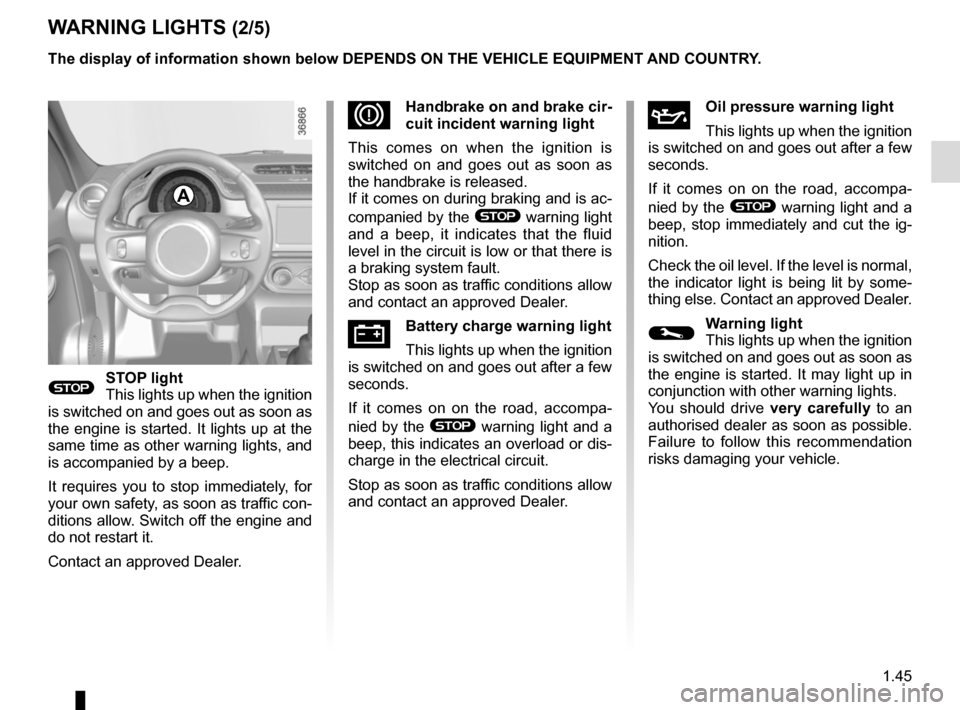
1.45
WARNING LIGHTS (2/5)
®STOP light
This lights up when the ignition
is switched on and goes out as soon as
the engine is started. It lights up at the
same time as other warning lights, and
is accompanied by a beep.
It requires you to stop immediately, for
your own safety, as soon as traffic con-
ditions allow. Switch off the engine and
do not restart it.
Contact an approved Dealer.
ÀOil pressure warning light
This lights up when the ignition
is switched on and goes out after a few
seconds.
If it comes on on the road, accompa-
nied by the
® warning light and a
beep, stop immediately and cut the ig-
nition.
Check the oil level. If the level is normal,
the indicator light is being lit by some-
thing else. Contact an approved Dealer.
©Warning light
This lights up when the ignition
is switched on and goes out as soon as
the engine is started. It may light up in
conjunction with other warning lights.
You should drive very carefully to an
authorised dealer as soon as possible.
Failure to follow this recommendation
risks damaging your vehicle.
DHandbrake on and brake cir-
cuit incident warning light
This comes on when the ignition is
switched on and goes out as soon as
the handbrake is released.
If it comes on during braking and is ac-
companied by the
® warning light
and a beep, it indicates that the fluid
level in the circuit is low or that there is
a braking system fault.
Stop as soon as traffic conditions allow
and contact an approved Dealer.
ÚBattery charge warning light
This lights up when the ignition
is switched on and goes out after a few
seconds.
If it comes on on the road, accompa-
nied by the
® warning light and a
beep, this indicates an overload or dis-
charge in the electrical circuit.
Stop as soon as traffic conditions allow
and contact an approved Dealer.
The display of information shown below DEPENDS ON THE VEHICLE EQUIPMENT \
AND COUNTRY.
A
Page 52 of 228
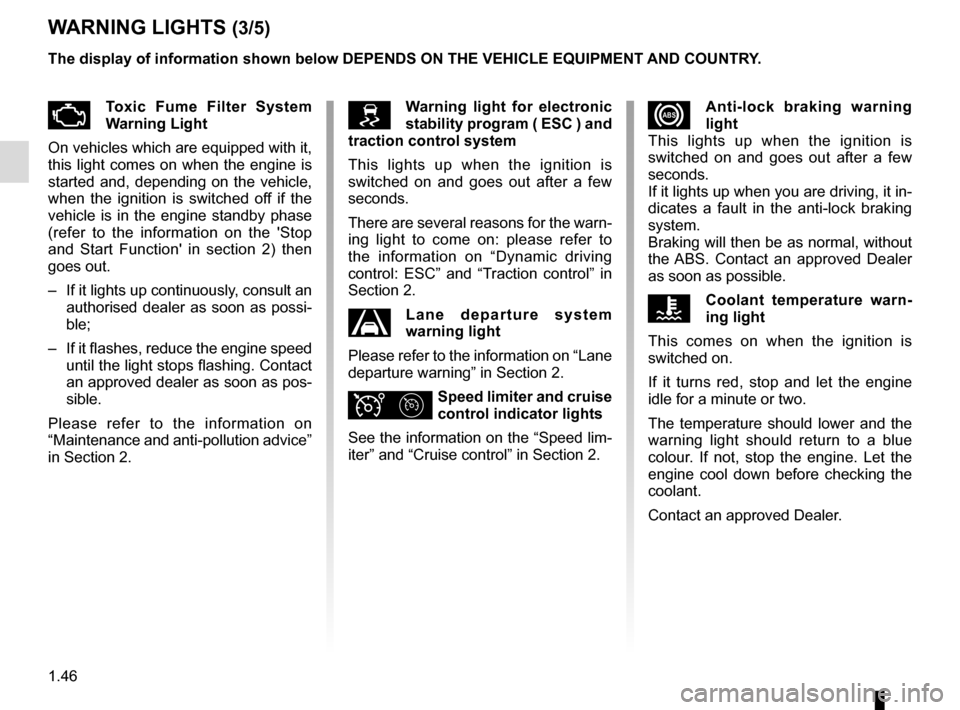
1.46
xAnti-lock braking warning
light
This lights up when the ignition is
switched on and goes out after a few
seconds.
If it lights up when you are driving, it in-
dicates a fault in the anti-lock braking
system.
Braking will then be as normal, without
the ABS. Contact an approved Dealer
as soon as possible.
ÔCoolant temperature warn-
ing light
This comes on when the ignition is
switched on.
If it turns red, stop and let the engine
idle for a minute or two.
The temperature should lower and the
warning light should return to a blue
colour. If not, stop the engine. Let the
engine cool down before checking the
coolant.
Contact an approved Dealer.
WARNING LIGHTS (3/5)
ÄToxic Fume Filter System
Warning Light
On vehicles which are equipped with it,
this light comes on when the engine is
started and, depending on the vehicle,
when the ignition is switched off if the
vehicle is in the engine standby phase
(refer to the information on the 'Stop
and Start Function' in section 2) then
goes out.
– If it lights up continuously, consult an authorised dealer as soon as possi-
ble;
– If it flashes, reduce the engine speed until the light stops flashing. Contact
an approved dealer as soon as pos-
sible.
Please refer to the information on
“Maintenance and anti-pollution advice”
in Section 2.Warning light for electronic
stability program ( ESC ) and
traction control system
This lights up when the ignition is
switched on and goes out after a few
seconds.
There are several reasons for the warn-
ing light to come on: please refer to
the information on “Dynamic driving
control: ESC” and “Traction control” in
Section 2.
Lane departure system
warning light
Please refer to the information on “Lane
departure warning” in Section 2.
ΦSpeed limiter and cruise
control indicator lights
See the information on the “Speed lim-
iter” and “Cruise control” in Section 2.
The display of information shown below DEPENDS ON THE VEHICLE EQUIPMENT \
AND COUNTRY.
Page 53 of 228
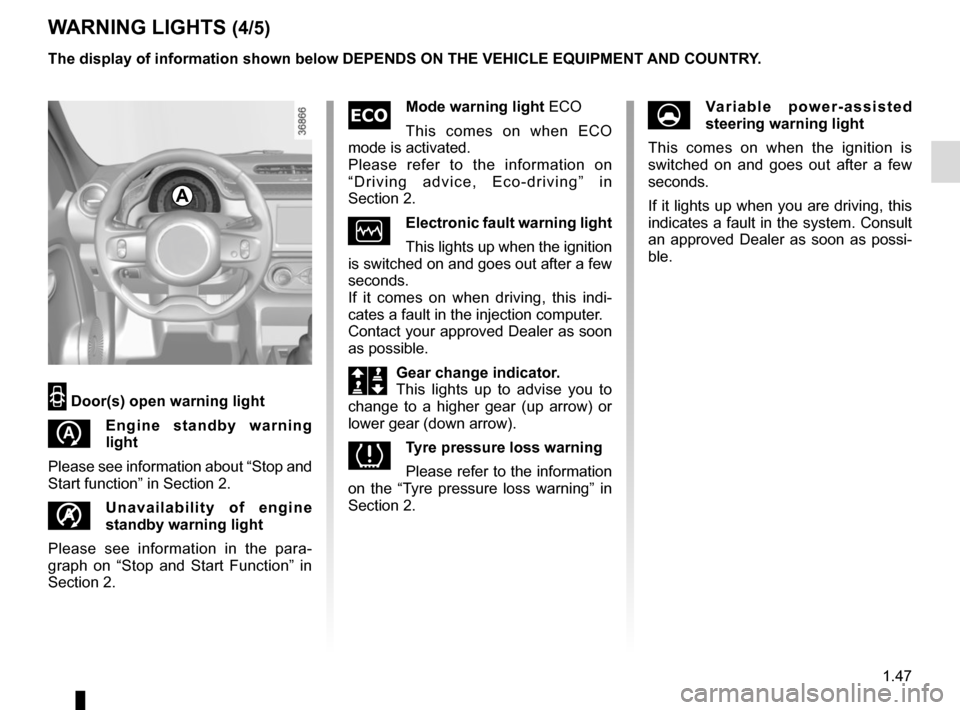
1.47
WARNING LIGHTS (4/5)
2 Door(s) open warning light
Engine standby warning
light
Please see information about “Stop and
Start function” in Section 2.
Unavailability of engine
standby warning light
Please see information in the para-
graph on “Stop and Start Function” in
Section 2.
Mode warning light ECO
This comes on when ECO
mode is activated.
Please refer to the information on
“Driving advice, Eco-driving” in
Section 2.
ÒElectronic fault warning light
This lights up when the ignition
is switched on and goes out after a few
seconds.
If it comes on when driving, this indi-
cates a fault in the injection computer.
Contact your approved Dealer as soon
as possible.
Š‰Gear change indicator.
This lights up to advise you to
change to a higher gear (up arrow) or
lower gear (down arrow).
\bTyre pressure loss warning
Please refer to the information
on the “Tyre pressure loss warning” in
Section 2.
The display of information shown below DEPENDS ON THE VEHICLE EQUIPMENT \
AND COUNTRY.
UVariable power-assisted
steering warning light
This comes on when the ignition is
switched on and goes out after a few
seconds.
If it lights up when you are driving, this
indicates a fault in the system. Consult
an approved Dealer as soon as possi-
ble.
A
Page 54 of 228
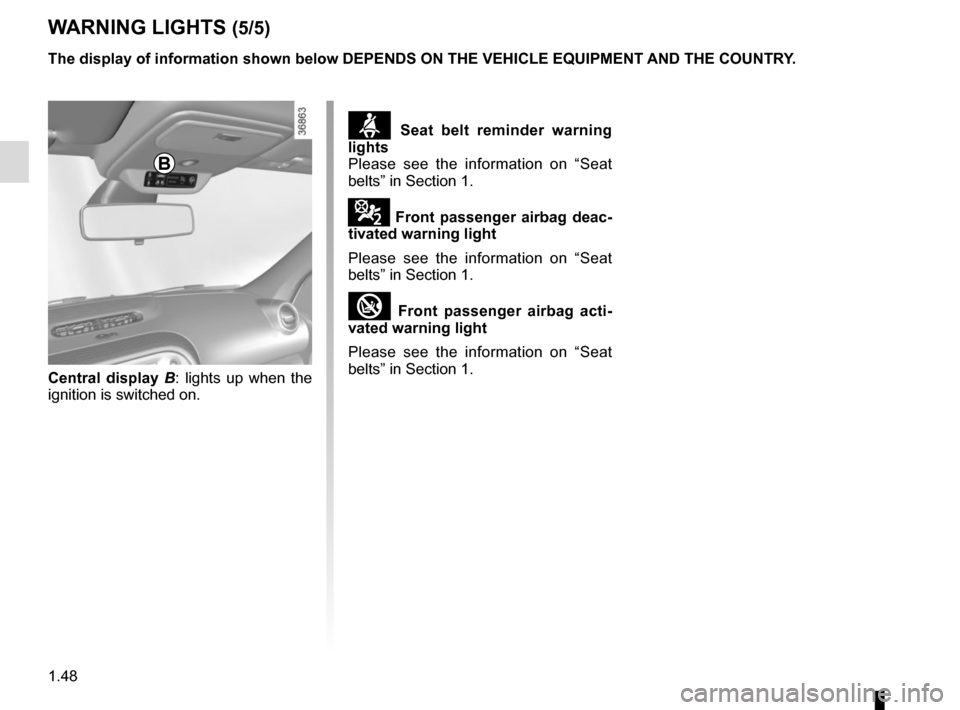
1.48
Central display B: lights up when the
ignition is switched on.
B
ß Seat belt reminder warning
lights
Please see the information on “Seat
belts” in Section 1.
¹ Front passenger airbag deac-
tivated warning light
Please see the information on “Seat
belts” in Section 1.
Front passenger airbag acti-
vated warning light
Please see the information on “Seat
belts” in Section 1.
WARNING LIGHTS (5/5)
The display of information shown below DEPENDS ON THE VEHICLE EQUIPMENT \
AND THE COUNTRY.
Page 55 of 228
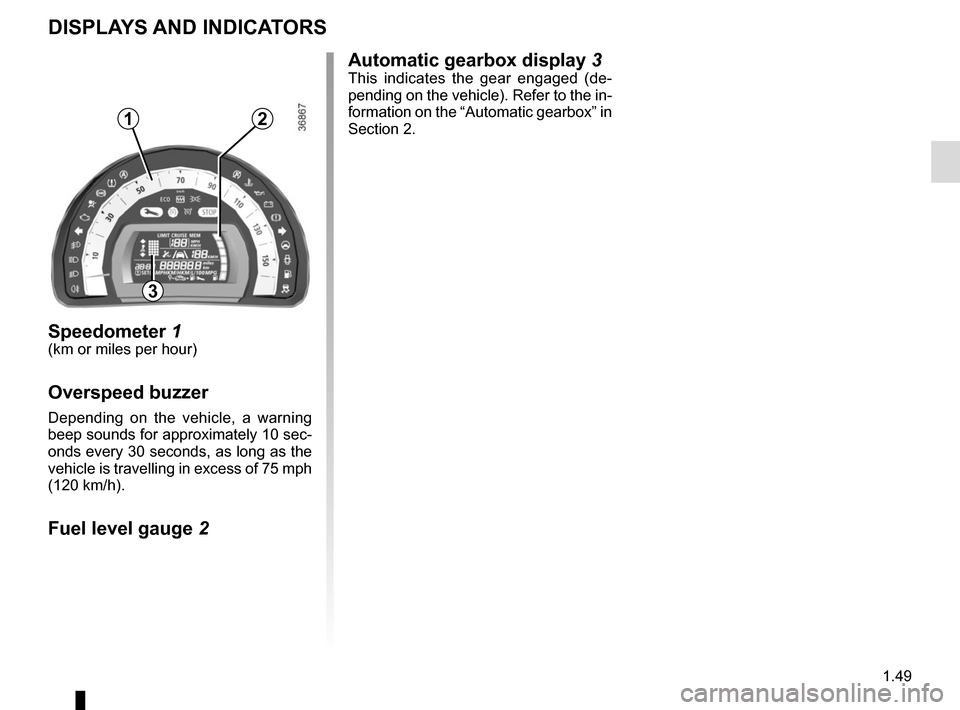
1.49
DISPLAYS AND INDICATORS
Speedometer 1(km or miles per hour)
Overspeed buzzer
Depending on the vehicle, a warning
beep sounds for approximately 10 sec-
onds every 30 seconds, as long as the
vehicle is travelling in excess of 75 mph
(120 km/h).
Fuel level gauge 2Automatic gearbox display
3
This indicates the gear engaged (de-
pending on the vehicle). Refer to the in-
formation on the “Automatic gearbox” in
Section 2.
1
3
2
Page 56 of 228
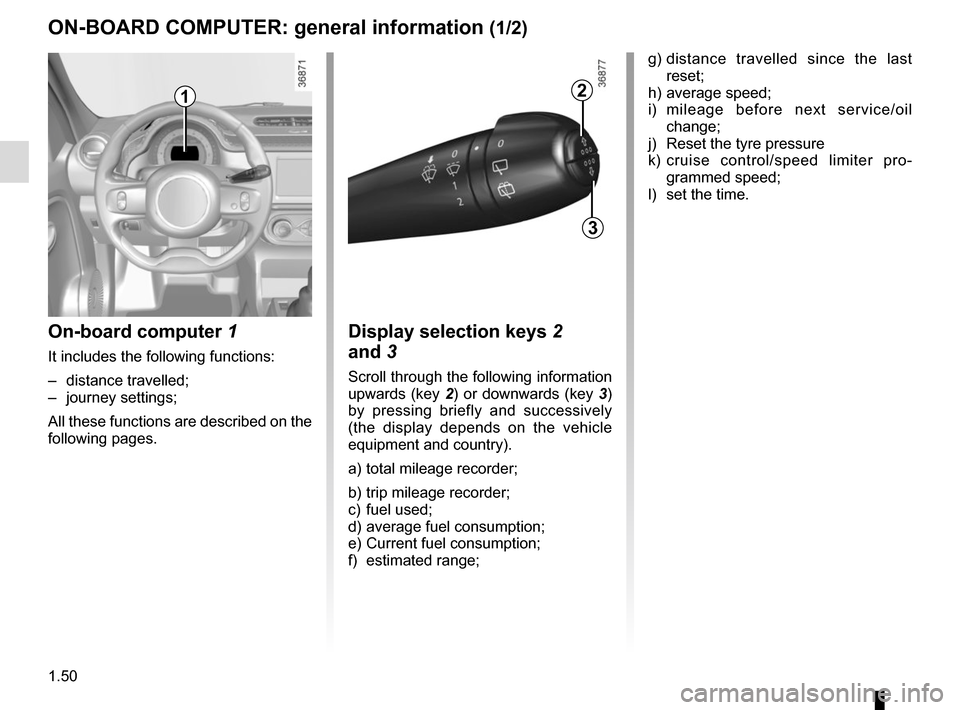
1.50
ON-BOARD COMPUTER: general information (1/2)
On-board computer 1
It includes the following functions:
– distance travelled;
– journey settings;
All these functions are described on the
following pages.
Display selection keys 2
and 3
Scroll through the following information
upwards (key 2) or downwards (key 3)
by pressing briefly and successively
(the display depends on the vehicle
equipment and country).
a) total mileage recorder;
b) trip mileage recorder;
c) fuel used;
d) average fuel consumption;
e) Current fuel consumption;
f) estimated range;
2
3
1
g) distance travelled since the last reset;
h) average speed;
i) mileage before next service/oil change;
j) Reset the tyre pressure
k) cruise control/speed limiter pro- grammed speed;
l) set the time.
Page 57 of 228
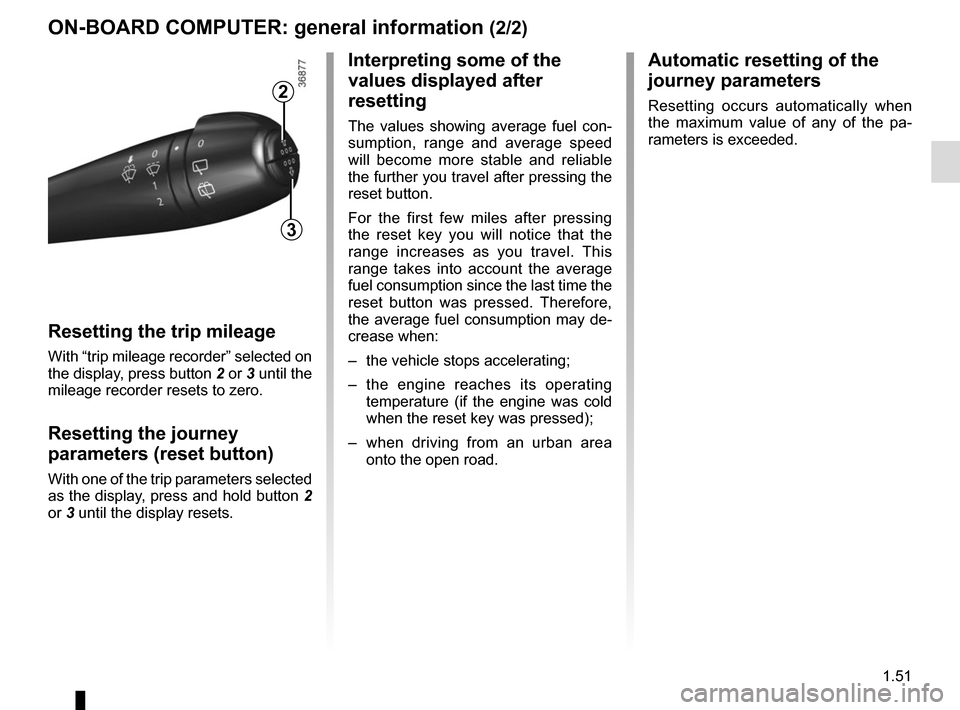
1.51
ON-BOARD COMPUTER: general information (2/2)
Resetting the trip mileage
With “trip mileage recorder” selected on
the display, press button 2 or 3 until the
mileage recorder resets to zero.
Resetting the journey
parameters (reset button)
With one of the trip parameters selected
as the display, press and hold button 2
or 3 until the display resets.
Interpreting some of the
values displayed after
resetting
The values showing average fuel con-
sumption, range and average speed
will become more stable and reliable
the further you travel after pressing the
reset button.
For the first few miles after pressing
the reset key you will notice that the
range increases as you travel. This
range takes into account the average
fuel consumption since the last time the
reset button was pressed. Therefore,
the average fuel consumption may de-
crease when:
– the vehicle stops accelerating;
– the engine reaches its operating
temperature (if the engine was cold
when the reset key was pressed);
– when driving from an urban area
onto the open road.
Automatic resetting of the
journey parameters
Resetting occurs automatically when
the maximum value of any of the pa-
rameters is exceeded.2
3
Page 58 of 228
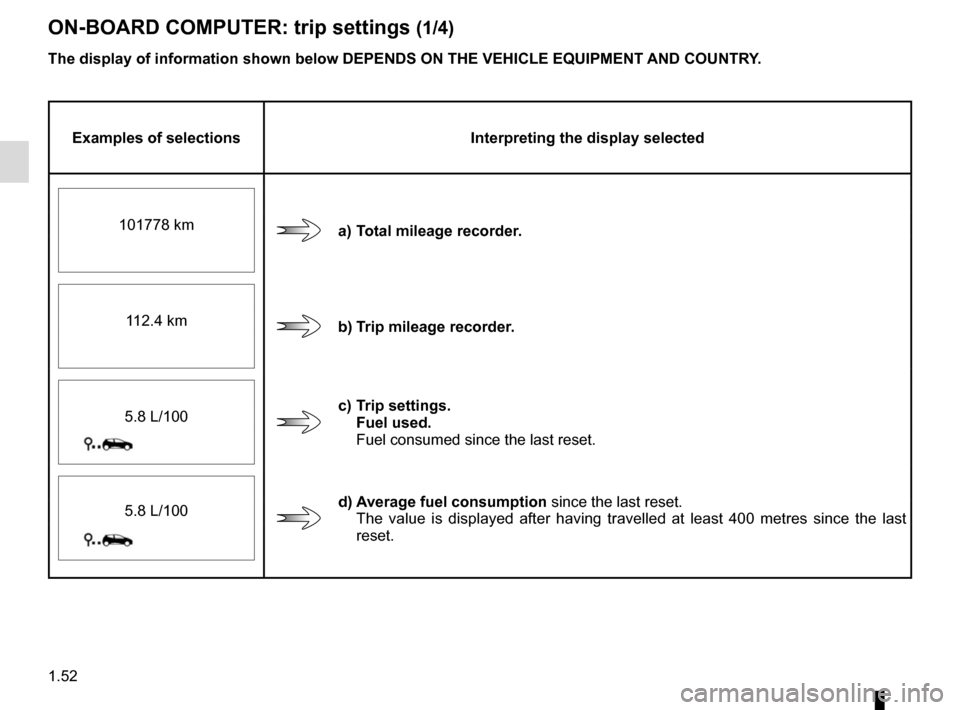
1.52
ON-BOARD COMPUTER: trip settings (1/4)
The display of information shown below DEPENDS ON THE VEHICLE EQUIPMENT \
AND COUNTRY.
Examples of selectionsInterpreting the display selected
a) Total mileage recorder.
101778 km
b) Trip mileage recorder.
112.4 km
c) Trip settings.
Fuel used.
Fuel consumed since the last reset.
5.8 L/100
d) Average fuel consumption
since the last reset.
The value is displayed after having travelled at least 400 metres since \
the last
reset.
5.8 L/100
Page 59 of 228
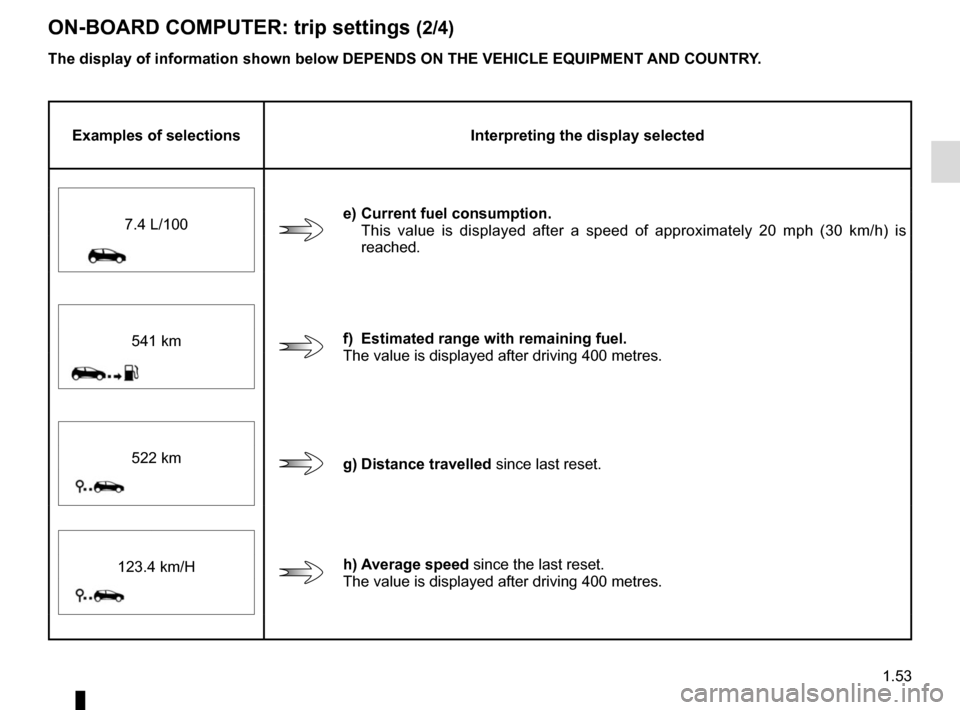
1.53
ON-BOARD COMPUTER: trip settings (2/4)
The display of information shown below DEPENDS ON THE VEHICLE EQUIPMENT \
AND COUNTRY.
Examples of selectionsInterpreting the display selected
e) Current fuel consumption.
This value is displayed after a speed of approximately 20 mph (30 km/h)\
is
reached.
7.4 L/100
f) Estimated range with remaining fuel.
The value is displayed after driving 400 metres.
541 km
g) Distance travelled since last reset.
522 km
h) Average speed since the last reset.
The value is displayed after driving 400 metres.
123.4 km/H
Page 60 of 228
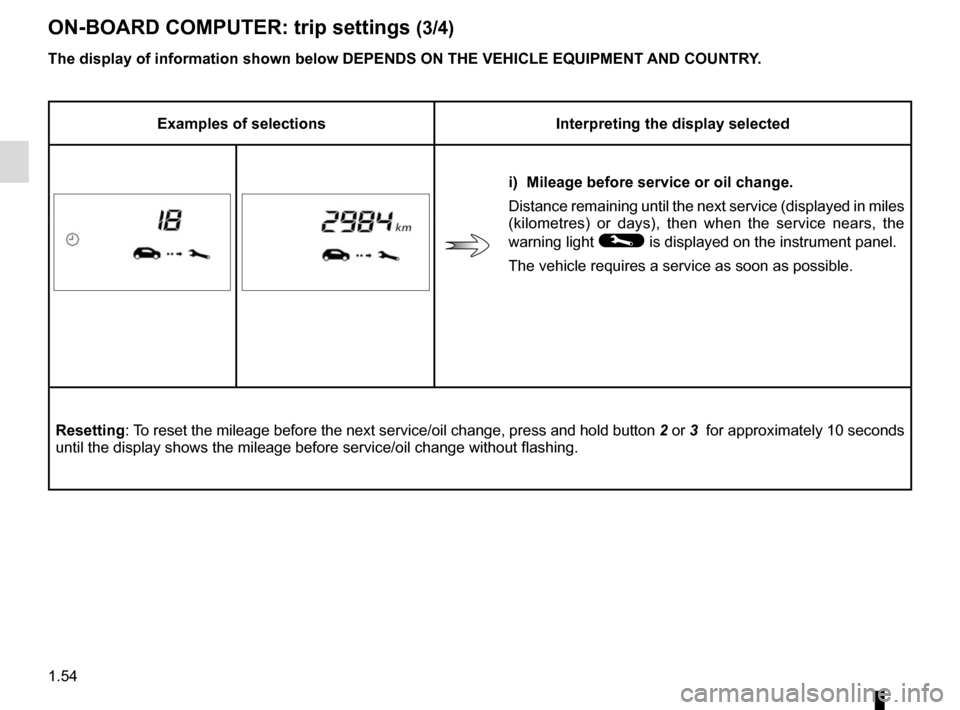
1.54
ON-BOARD COMPUTER: trip settings (3/4)
The display of information shown below DEPENDS ON THE VEHICLE EQUIPMENT \
AND COUNTRY.
Examples of selectionsInterpreting the display selected
i) Mileage before service or oil change.
Distance remaining until the next service (displayed in miles
(kilometres) or days), then when the service nears, the
warning light
© is displayed on the instrument panel.
The vehicle requires a service as soon as possible.
Resetting: To reset the mileage before the next service/oil change, press and hold b\
utton 2 or 3 for approximately 10 seconds
until the display shows the mileage before service/oil change without fl\
ashing.